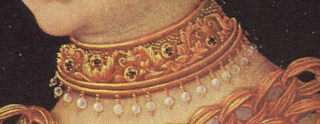So while you are all absorbed in the title statment, and A- running in fear with the misconceptions of horned hat wearing, mead drinking 'neaderthalls'. Or B - Thinking of the History Channel's show Vikings. Which is kinda sorta, themed in the correct wear of the Vikings.
I'm here to SAVE you and point you in the right direction with the correct knowledge.
A little known or widely known, if you are new to the Viking culture, one must know this invaluable research resource. The Viking Answer Lady!
http://www.vikinganswerlady.com/clothing.shtml I've linked you to the clothing section, because that is what we are going to talk about, the basic construction, then move on to things like, shoes, and bling.
As with every kind of costume, culture has a huge influence on the clothing. So while the people are you thinking of, run around half naked and, pilliage, muder and rape. I need to change our conception of the culture.
Vikings were first and foremost explorers and they were very serious about their gods. While I would love to talk more culture, I'm a clothes enthusiast!
This is the Down and dirty on how to make your Viking dress.
http://www.cs.vassar.edu/~capriest/qdirtyvk.html This details, colors, cut, construction and trims used in the era.
Lets start with the Basic Under tunic. Its comfy and gennerally made out of linen.
Both men and women patterns and shapes can be found here at this link.
http://www.cs.vassar.edu/~capriest/viktunic.html
While it has the basic construction tips, Let me give you a verbal idea of how to do it. Not because I am lazy, but beause I sometimes just don't have the time nor the patience to deal multiple pieces and I secretly despise geometric shapes. I think thats because I enjoy the more complexe elizabethan and Tudor shapes from whence I started sewing.
Females, Measure the widest part of your body. Most commonly this is your hips, other cases are your bust. Now Add four inches. This is to be able to slip it up and over your body and not to get stuck in your own garment.
Neck measurement
shoulder width, from one end to the other. You should be able to raise your arm and feel the little indent there to go off of,. Some use it, some dont, Thats just how I measure.
Bust
Natural waist line
Hips
Make a fist and measure around the hand. - Add two inches - Seam Allowance.
NOTE: Remember if you are going to fold your fabric, say hamburger style, you have to half your measurements for the pattern.
If you hamburger fold and then hot dog fold, you have to half your half. Confusing I know.
So lets talk numbers
Say the neck measurement is 14 inches. 14" devided by 4 = 3.5" Thats your neck hole. Don't forget to add a 1/4" seam allowence or 1/2" depending on your prefrence.
Most likely if you have gotten this far, I have by far confused you all!
This is the time I include a picture to stop the madness.
If you laid out you pattern this way, all measurements will be 1/2 of the original measurments.
You want to leave your shoulder measurement alone, the triangle gussets at the bottom make up for the hip room.
You want your two main body rectangles to reflect the widest part of your body measurements so you can get it off and on.
Don't do the mistake I did, and try to make the garment with no ease. I got stuck in my own garment and waisted fabric. It was horribleand costly mistake.
Now I mentioned a cheater method. Its simple. Half your fabric at the shoulder seam for the length you want. I normally go from the shoulder to the ankle, then add two inches, for hemming.
I then hot dog and devide my measurements by 4. I cut it all as once piece. If your crunched for time you can do this.
However for those enthusiast who want to go te distance. Go for this! You can even get a coat pattern out of this.
"Textile Choices
Some garments, particularly undergarments, were made of linen, hemp, or
nettlecloth: many such smocks and the occasional coat have been found. Although
other forms of linen weaving were known at the time, the archaeological evidence
indicates that almost all of these materials were in tabby weave. Linen, ramie-
cotton, or cotton-linen blends in tabby weave are easy to find and make very
appropriate choices for smocks, gowns, and lightweight coats."
The link above shows how one gets a coat out of the same pattern. The vikings were pretty nifty, one pattern could go a long long LOOONG way. Heres the link again.
http://www.cs.vassar.edu/~capriest/viktunic.html
So lets recap! Undertunics, can be used for a shirt, by shortining the pattern, used as a coat, by splitting the pattern and also used a coat or jacket by modifying the pattern.
Which is awesome!
Lets talk Apron Dresses next!
of the apron dress should sit at your nipple level. The over all circumfrance should encase your bust line.
Anothe way to do this, is to simply wrap a length of fabric around your body to get the measuremen then add wide gores into the skirt, one at each side and one in the back. The apron should fall about six inches blow the knee.
I trim the top and the bottom with inkle woven trim or trime from local sources to bling it up.
Straps can be sewn like this, or done in one long strip sewin to the center back for ease.
Where does my bling go? The turtle shell shaped like brooches pin the straps to the apron dress.
Example of wool coat with silk trim.
Hats oh my!
A recent dress for a client with long straps and embroidered apron dress. The undertunic features a keyhole neckline.
Example of Viking Brooches. Google Search Image.
Anoher example of ladies viking wear. Google search Image.












